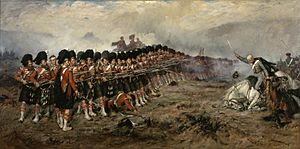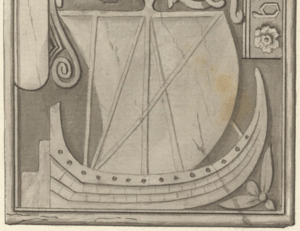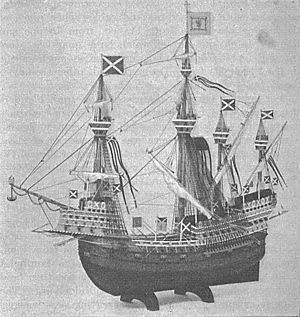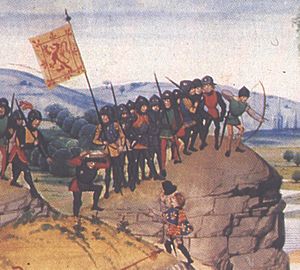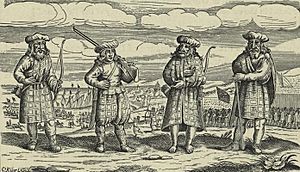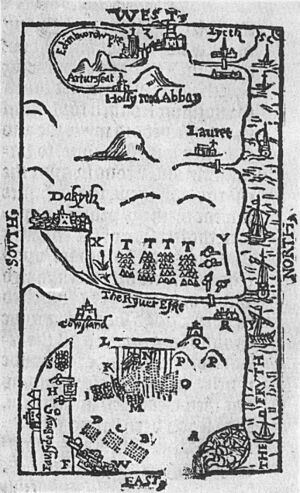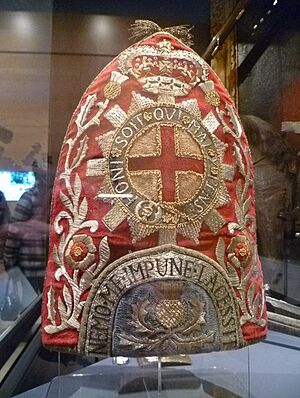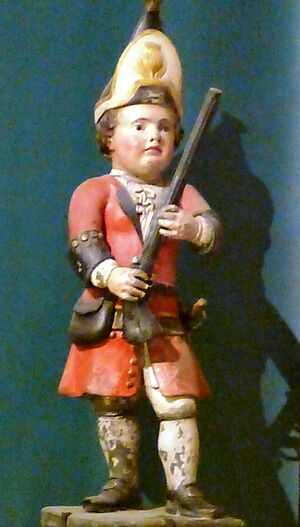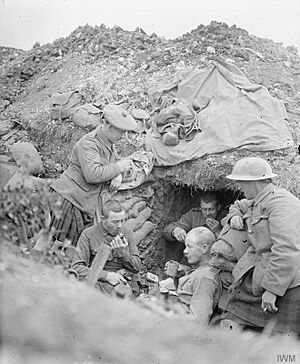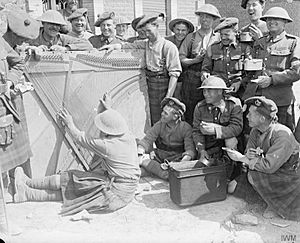Military history of Scotland facts for kids
Historically, Scotland has a long military tradition that started long before it joined with England in 1707. Today, Scottish soldiers are part of the armed forces of the United Kingdom, often called the British Armed Forces.
Contents
- Scotland's Military Before the Union
- Scotland as Part of the British Armed Forces
- Defence Establishments in Scotland
- Scottish Regiments in Other Countries
- See also
Scotland's Military Before the Union
Ancient records mention Scottish kings like William the Lion and Alexander II leading fleets of ships. In 1249, Alexander II commanded a large naval force to fight the Kingdom of the Isles, but he died before the battle.
Viking naval power was strong but faced challenges. In the 13th century, Norwegian kings built huge ships. King Hakon Hakonsson's Kristsúðin, built in 1262, was about 79 meters (260 feet) long! In 1263, Hakon brought 40 ships, including the Kristsúðin, to the Scottish islands. With local allies, his fleet grew to 200 ships. Alexander III built some large ships too but avoided a sea battle. After a land defeat at the Battle of Largs and bad winter storms, the Norwegian fleet went home. This made Scotland the main power in the region, and the Western Isles were given to Alexander in 1266.
English naval power helped Edward I in his campaigns against Scotland starting in 1296. He used merchant ships from England, Ireland, and his allies to move and supply his armies. Robert I succeeded partly because he could use naval forces from the Scottish islands. He also gained support from a major naval power in the North Sea when the Flemings were expelled from England in 1303.
Naval power helped Robert I defeat English attempts to capture him in the Highlands. It also allowed him to blockade English fortresses at Perth and Stirling. This blockade forced Edward II to try to relieve Stirling, which led to the English defeat at Bannockburn in 1314. Scottish naval forces also helped invade the Isle of Man in 1313 and 1317, and Ireland in 1315. They were also key to the blockade of Berwick, which fell in 1318.
After Scotland became independent, Robert I focused on building up its navy. This was mainly on the west coast. Records from 1326 show that his vassals (landowners) in that area had to help him with their ships and crews. Near the end of his rule, he oversaw the building of at least one royal man-of-war (a warship) near his palace at Cardross on the River Clyde.
In the late 14th century, naval battles with England were mostly fought by hired Scottish, Flemish, and French merchant ships and privateers (private ships allowed to attack enemy ships). James I was very interested in naval power. After returning to Scotland in 1424, he set up a shipbuilding yard at Leith. He also built a house for marine supplies and a workshop. Royal ships were built there for both trade and war. The job of Lord High Admiral likely started around this time. In 1488, James III got help from his two warships, the Flower and the King's Carvel (also known as the Yellow Carvel).
There were several attempts to create royal navies in the 15th century. James IV took this to a new level. He founded a harbor at Newhaven and a dockyard at Airth. He acquired 38 ships, including the Great Michael, which was the largest ship in Europe at the time. Scottish ships had some success against privateers, joined the king on his trips to the islands, and got involved in conflicts in Scandinavia and the Baltic. However, most were sold after the Flodden campaign in 1513 and after 1516. After this, Scottish naval efforts relied on privateers and hired merchant ships.
James V didn't share his father's interest in building a navy, and shipbuilding fell behind other countries. Even with truces between England and Scotland, there were often small naval wars called guerre de course (raiding warfare). James V built a new harbor at Burntisland in 1542. The main use of naval power during his reign was for trips to the Isles and France.
After the Union of Crowns in 1603, when Scotland and England shared a king, conflicts between the two countries ended. But Scotland then got involved in England's foreign policy, which meant Scottish ships could be attacked. In 1626, Scotland bought and equipped three warships. There were also several fleets of privateers who had a letter of marque (permission to attack enemy ships). In 1627, the Royal Scots Navy and privateers took part in a big expedition to Biscay. Scots also went to the West Indies and helped capture Quebec in 1629.
During the Bishop's Wars (a conflict with King Charles I), the king tried to blockade Scotland. He also planned attacks from England on the east coast and from Ireland on the west. Scottish privateers captured several English ships. After the Covenanters (a Scottish religious and political movement) allied with the English Parliament, they set up two patrol groups for the Atlantic and North Sea coasts, known as the "Scotch Guard."
The Scottish navy couldn't stand against the English fleet that came with Cromwell's army, which conquered Scotland in 1649–51. Scottish ships and crews were then split up among the English Commonwealth fleet. Scottish sailors were protected from being forced into the English navy, but a certain number of conscripts (people forced to join the military) were taken from coastal towns in the late 17th century. Royal Navy patrols were now seen in Scottish waters even during peacetime. In the Second (1665–67) and Third Anglo-Dutch Wars (1672–74), between 80 and 120 captains took Scottish letters of marque, and privateers played a big part in the naval fighting.
In the 1690s, a small fleet of five ships was created by merchants for the Darien Scheme (a Scottish attempt to set up a colony in Panama). A professional navy was also created to protect trade in Scottish waters during the Nine Years' War. Three warships were bought from English shipbuilders in 1696. After the Act of Union in 1707, these ships were transferred to the Royal Navy.
Scottish Armies
Before the Wars of the Three Kingdoms in 1644, Scotland didn't have a standing army (a permanent, professional army). In the Early Middle Ages, war in Scotland involved small groups of household troops, often raiding and fighting small battles. By the High Middle Ages, Scottish kings could gather tens of thousands of men for short periods. This "common army" was mainly made up of lightly armored spearmen and archers.
After the "Davidian Revolution" in the 12th century, which brought parts of feudalism (a system where land is exchanged for service) to Scotland, these forces were joined by small numbers of mounted and heavily armored knights. These armies rarely matched the usually larger and more professional English armies. However, Robert I of Scotland used them very well at the Battle of Bannockburn in 1314 to secure Scottish independence.
After the Wars of Scottish Independence, the Auld Alliance (a long-standing alliance) between Scotland and France played a big part in Scotland's military actions, especially during the Hundred Years' War. In the Late Middle Ages, under the Stewart kings, forces were further boosted by specialist troops like men-at-arms and archers. These were hired through agreements called manrent, similar to English indentures.
Scottish warfare in this period mostly involved raids and ambushes by Scottish nobles and men-at-arms. They would fight on foot in big battles or on horseback for skirmishes and raids. Pictures from the time show nobles and their followers in strong plate armor, good for foot combat. Many wore great bascinets (helmets) late into the 15th century, possibly for extra protection from English bows and bills (a type of weapon). They were joined by their followers, usually mounted longbowmen or spearmen, who also preferred to fight on foot in pitched battles.
Archers became very popular as mercenaries (hired soldiers) in French armies in the 15th century. This was to help counter the English advantage in archery. Scottish archers became a major part of the French royal guards, known as the Garde Écossaise. Scotland played a big role in the Hundred Years' War, with many Scots present from the Battle of Bauge to the end of the Loire Valley Campaign and the Battle of Patay.
The Stewarts also adopted new ideas in warfare from Europe, such as longer pikes (long spears) and using a lot of artillery (cannons). However, in the early 16th century, one of the largest and best-armed Scottish armies ever gathered was defeated by an English army at the Battle of Flodden in 1513. This battle led to the loss of many ordinary soldiers, a large part of the nobility, and King James IV himself.
In the 16th century, the king played a bigger role in providing military equipment. The pike began to replace the spear, and Scots started using gunpowder firearms instead of bows. Feudal heavy cavalry (knights on horseback) began to disappear from Scottish armies. Instead, Scots used relatively large numbers of light horsemen, often from the border regions. James IV brought experts from France, Germany, and the Netherlands and set up a gun foundry (a place to make cannons) in 1511.
A clan leader like John Grant of Freuchie in 1596 could gather 500 men from his family, friends, and servants to fight for King James. Of these, 40 had habergeons (chainmail shirts), two-handed swords, and helmets. Another 40 were armed "according to the Highland custom" with bows, helmets, swords, and targes (small shields).
In the early 17th century, many Scots joined foreign armies fighting in the Thirty Years' War. As conflict with King Charles I in the Bishop's Wars became likely, hundreds of Scottish mercenaries returned home. These experienced leaders, like Alexander and David Leslie, were important in training new soldiers. These systems formed the basis of the Covenanter armies that fought in the Civil Wars in England and Ireland.
Scottish infantry (foot soldiers) were usually armed with a mix of pikes and firearms, which was common in Western Europe. Scottish armies might also have had individuals with various weapons, including bows, Lochaber axes, and halberds (a two-handed pole weapon). Most cavalry (soldiers on horseback) probably had pistols and swords, though some might have been lancers (using spears). Royalist armies, like those led by James Graham, Marquis of Montrose (1643–44), were mainly made up of infantry with pikes and firearms. Montrose's forces lacked heavy artillery for sieges and had only a small cavalry force.

After the Restoration (when the monarchy was brought back), the Privy Council (a group of advisors to the king) created several infantry regiments and some troops of horsemen. There were also attempts to create a national militia (a citizen army) like England's. The standing army was mainly used to put down Covenanter rebellions and the guerrilla war fought by the Cameronians. Pikemen became less important in the late 17th century and disappeared after the socket bayonet (a knife attached to a musket) was introduced. Matchlock muskets (fired by a burning match) were replaced by more reliable flintlocks (fired by a spark from flint).
Before the Glorious Revolution (1688), the standing army in Scotland had about 3,000 men in different regiments. Another 268 veterans were in major garrison towns like Edinburgh, Dumbarton, and Stirling. After the Glorious Revolution, Scots were drawn into King William II's wars in Europe, starting with the Nine Years' War in Flanders (1689–97). By the time of the Act of Union in 1707, the Kingdom of Scotland had a standing army of seven infantry units, two horse units, and one troop of Horse Guards, plus artillery in its castles.
Wars and Battles to 1707

- Scottish–Norwegian War
- Wars of Scottish Independence
- Anglo-Scottish Wars
- War of the League of Cambrai
- Rough Wooing
- Marian civil war
- Wars of the Three Kingdoms
- Jacobite risings
Castles

Castles came to Scotland with feudalism in the 12th century. At first, they were wooden motte-and-bailey castles (a mound with a wooden tower and a fenced courtyard). Many were later replaced by stone castles with high walls. During the Scottish Wars of Independence, Robert the Bruce often destroyed castles so the English couldn't use them.
In the late Middle Ages, new castles were built, some much larger. These were "livery and maintenance" castles that could hold a big army. Gunpowder weapons led to changes in castle design, like gun ports (holes for cannons), platforms for guns, and stronger walls to resist cannon fire.
Many late Medieval castles built in the border areas were tower houses (tall, narrow defensive homes), smaller pele towers, or simpler bastle houses (fortified farmhouses). From the 15th century, there was a trend of building Renaissance palaces. These were redesigned as castle-like palaces, starting with Linlithgow.
Parts of Medieval castles, royal palaces, and tower houses were used in building Scots baronial estate houses. These were mostly built for comfort but looked like castles. In the 17th and 18th centuries, castles became less important for military defense but grew in popularity as tourist attractions. The Scots Baronial style was revived in the late 18th century. This trend became very popular when Balmoral Castle was rebuilt in the 19th century and used by Queen Victoria as a retreat. In the 20th century, only a few new houses were built with castle influences.
Scotland as Part of the British Armed Forces
After the Act of Union in 1707, the Scottish Army and Navy joined with those of England. The new British Army included existing Scottish regiments (military units), such as the Scots Guards and The Royal Scots. The three ships of the small Royal Scottish Navy were transferred to the Royal Navy. For example, the Royal William became HMS Edinburgh. The new Armed Forces were controlled by the War Office and Admiralty in London.
From the mid-18th century, the British Army began to recruit many Highlanders (people from the Scottish Highlands). The first official Highland regiment for the British army was the Black Watch in 1740. However, the growth of Highland regiments was slowed by the 1745 Jacobite Rebellion (a fight to restore the Stuart kings). During this time, Scottish soldiers and sailors were very important in helping the British Empire grow and were involved in many international conflicts. These included the War of the Spanish Succession (1702–13) and the American Wars of Independence (1775–83).
Napoleonic Wars
Scots had a big impact on warfare during the Napoleonic Wars (early 1800s). Important sailors of this time included:
- Admiral Sir Charles (John) Napier.
- Admiral Adam Duncan, 1st Viscount Duncan of Camperdown, who led the Royal Navy to defeat the Dutch at the Battle of Camperdown in 1797.
- Admiral Thomas Cochrane, 10th Earl of Dundonald, one of the bravest and most successful captains of the Napoleonic Wars. The French called him "le loup de mer" ("the sea wolf"). After being dismissed from the Royal Navy, he served in the navies of Chile, Brazil, and Greece during their fights for independence. He was later brought back as an admiral in the Royal Navy. His life inspired the famous fictional characters Horatio Hornblower and Jack Aubrey.
- Lieutenant-general Sir John Moore.
- Alexander Abercromby.
- Thomas Graham, 1st Baron Lynedoch.
- George Ramsay, 9th Earl of Dalhousie.
- Robert Craufurd.
- John Hope, 4th Earl of Hopetoun.
First World War
Field Marshal Sir Douglas Haig led the British Army on the Western Front from 1915. He oversaw some of the largest and bloodiest battles of the war, including the Somme (1916) and Ypres (1917). Because Scottish soldiers wore kilts on the battlefield, their German enemies called them the "ladies from hell." Haig later started the Earl Haig Poppy Fund to help former servicemen.
According to historian T. C. Smout, it's believed that about 110,000 Scots died in the war. This was about 10% of the Scottish male population aged 16 to 50. It was also likely about 15% of all British war deaths, meaning Scotland's sacrifice was higher in proportion than any other country in the Empire.
Second World War
Scottish soldiers fought in many battles during World War II, in both the Pacific and European areas.
Defence Establishments in Scotland
Army
After the Jacobite risings (attempts to put the Stuart kings back on the throne), several fortresses were built across the Highlands in the 18th century by General Wade to bring peace to the region. These included Fort George, Fort Augustus, and Fort William. The Ordnance Survey (a mapping agency) was also asked to map the area.
Later, because of their landscape and feeling of being far away, parts of Scotland have been home to many important defense sites, some of which have caused debate. During World War II, Allied and British Commandos trained at Achnacarry in the Highlands. The island of Gruinard was used for an exercise in biological warfare (using diseases as weapons).
Current British Army bases in Scotland include: Fort George near Inverness; Redford Barracks and Dreghorn Barracks in Edinburgh; and Glencorse Barracks at Penicuik.
Between 1960 and 1991, the Holy Loch was a base for the US Navy's fleet of Polaris-armed ballistic missile submarines. Today, HM Naval Base Clyde, about 40 kilometers (25 miles) west of Glasgow, is the base for the four Trident-armed ballistic missile submarines. These submarines carry about 200 Trident nuclear warheads. Since free-falling bombs were removed in 1998, the Trident SLBM system is the UK's only nuclear deterrent (a way to prevent attacks by threatening a strong response).
HMS Caledonia at Rosyth in Fife is the support base for navy operations in Scotland. It also serves as the Naval Regional Office for Scotland and Northern Ireland. The Royal Navy's LR5 and Submarine Rescue Service is based in Renfrew, near Glasgow. The Royal Navy's submarine nuclear reactor development site is at Vulcan NTRE, next to Dounreay. RM Condor at Arbroath, Angus is home to 45 Commando, Royal Marines. The Fleet Protection Group Royal Marines is also based at HMNB Clyde.
Since 1999, the Scottish Government has been responsible for fisheries protection in Scotland's waters. This is done by the Scottish Fisheries Protection Agency, which has four offshore patrol vessels and two Cessna 406 maritime patrol aircraft.
Royal Air Force
Only one main Royal Air Force (RAF) station is in Scotland. RAF Lossiemouth, in Moray, is the RAF's northern QRA(I) base (Quick Reaction Alert for intercepting aircraft). It is supported by four squadrons of Typhoons.
Military Training Areas
The only open-air test range for depleted uranium weapons in the British Isles is near Dundrennan. Because of this, over 7,000 weakly radioactive munitions are on the seabed of the Solway Firth. In 2007, the MoD (Ministry of Defence) owned or leased 1,153 square kilometers (445 square miles) of land in Scotland. This was 31.5% of the MoD's land in Britain. Important Training Areas include Garelochhead, Cape Wrath, Barry Buddon, and Castlelaw in the Pentland Hills.
Industry

Defence contractors and related companies employ about 30,000 people in Scotland. They are an important part of the Scottish economy. The main companies working in Scotland include: BAE Systems, Rolls-Royce, Raytheon, Thales, and Babcock.
- HMNB Clyde (HMS Neptune), Argyll and Bute
- Rosyth Dockyard (HMS Caledonia), Fife
- DM Beith, Beith, North Ayrshire
- RM Condor formerly HMS Condor, Arbroath, Angus
- Loch Ewe
- Scapa Flow, Orkney
- Invergordon, Easter Ross
- Port Edgar, South Queensferry, City of Edinburgh
- HMS Cochrane, Rosyth
- HMS Dundonald, Troon, Combined Operations Craft Working up base
- HMS Lochinvar. Minesweeping & Fisheries Protection Depot. Based at Port Edgar 1939–1943 and 1946–1975. Based at Granton 1943–1946
- HMS Western Isles, Tobermory, Argyll & Bute, Anti-submarine working up base
- HMS Condor, Arbroath, Angus
- HMS Fulmar, Lossiemouth, Moray
- HMS Gannet, Prestwick, South Ayrshire
- HMS Jackdaw, Crail, Fife
- HMS Landrail, Macrihanish, Argyll and Bute
- HMS Merlin, Donibristle, Fife
- HMS Nighthawk, Drem, East Lothian
- HMS Owl, Fearn, Wester Ross, Highland
- HMS Sanderling, Abbotsinch, Renfrewshire: (Now Glasgow International Airport)
- HMS Sparrowhawk, Hatston, Orkney
- HMS Tern, Twatt, Orkney
Royal Air Force Stations in Scotland
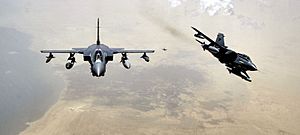
- RAF Benbecula
- RAF Kirknewton
- RAF Lossiemouth
- RAF Tain
Former Royal Air Force Stations in Scotland
|
|
|
Scottish Units in the British Army
Before 2006, the Scottish Infantry had several 'county regiments', each recruiting from a local area. In 2006, the remaining regiments, known as the Scottish Division, joined to form the Royal Regiment of Scotland. Many veterans and supporters of the old regiments strongly disagreed with this change.
Scottish soldiers serve alongside soldiers from England, Wales, and Northern Ireland in all Combat Support Arms and Services (like the RA, RE, and Signals), Special Forces, the Household Cavalry, and the Parachute Regiment of the British Army. The following current units have specific Scottish connections:
- 51 (Scottish) Brigade
- 52 Infantry Brigade
- Royal Regiment of Scotland
- Scots Guards
- Royal Scots Dragoon Guards
- 1st Royal Tank Regiment
- 19th Regiment Royal Artillery
- 40th Regiment Royal Artillery
- A (London Scottish) Company London Regiment
- 105th Regiment Royal Artillery
- 32 (Scottish) Signal Regiment
- 154 (Scottish) Regiment RLC
- A (Ayrshire (Earl of Carrick's Own) Yeomanry) & C (Fife and Forfar Yeomanry/Scottish Horse) Squadrons of the Queen's Own Yeomanry Regiment
Former Scottish Units in the British Army
- 9th (Scottish) Division
- 15th (Scottish) Division
- 51st (Highland) Division
- 52nd (Lowland) Division
- Highland Brigade
- Lowland Brigade
- 4th Royal Tank Regiment
- The Cameronians (Scottish Rifles)
- Glasgow Highlanders
- The Gordon Highlanders
- Highland Light Infantry
- Liverpool Scottish
- London Scottish
- King's Own Scottish Borderers
- Queen's Own Cameron Highlanders
- Queen's Own Highlanders (Seaforth and Camerons)
- The Royal Scots
- Royal Scots Fusiliers
- Scots Greys
- Seaforth Highlanders
- 93rd (Sutherland) Highlanders
Regular British Army Units Currently Based in Scotland
- The Royal Highland Fusiliers, 2nd Battalion The Royal Regiment of Scotland – Glencorse Barracks
- The Black Watch, 3rd Battalion The Royal Regiment of Scotland – Fort George
- 3rd Battalion, The Rifles – Redford Barracks
- Balaklava Company (Argylls) 5th Battalion The Royal Regiment of Scotland – Redford Barracks Edinburgh
- 39 Engineer Regiment (Kinloss Barracks)
- Royal Scots Dragoon Guards (Leuchars Station)
Scottish Units Not Part of the British Army
- Atholl Highlanders
- Royal Company of Archers
- High Constables of Holyroodhouse
Scottish Regiments in Other Countries
Australia
List of active regiments in the Australian Army:
- 5th/6th Battalion, Royal Victoria Regiment (Victorian Scottish Regiment)
- 10th/27th Battalion, Royal South Australia Regiment (South Australian Scottish Regiment)
- 16th Battalion, Royal Western Australia Regiment (Cameron Highlanders)
- 41st Battalion, Royal New South Wales Regiment (Byron Scottish Regiment)
List of former Scottish regiments in Australia:
- 30th Battalion (The New South Wales Scottish Regiment)
- 61st Battalion (The Queensland Cameron Highlanders)
List of former Scottish regiments in the Australian colonial forces:
- Byron Regiment (Sutherland)
- New South Wales Scottish Regiment
- South Australian Scottish Regiment
- Victorian Scottish Regiment (VSR)
Canada
List of active regiments in the Canadian Forces:
- 42nd Field Artillery Regiment (Lanark and Renfrew Scottish), RCA
- 48th Highlanders of Canada 1891
- The Argyll and Sutherland Highlanders of Canada (Princess Louise's) 1903
- The Black Watch (Royal Highland Regiment) of Canada 1862
- Cape Breton Highlanders 1871–1954 2011–present
- The Calgary Highlanders 1910
- The Cameron Highlanders of Ottawa (Duke of Edinburgh's Own) 1881
- The Canadian Scottish Regiment (Princess Mary's) 1912
- The Essex and Kent Scottish 1954
- The Lake Superior Scottish Regiment 1905
- The Lorne Scots (Peel, Dufferin and Halton Regiment) 1866
- The Nova Scotia Highlanders 1871
- The Queen's Own Cameron Highlanders of Canada 1910
- The Royal Highland Fusiliers of Canada late 1940s
- The Seaforth Highlanders of Canada 1910
- The Stormont, Dundas and Glengarry Highlanders 1804
- The Toronto Scottish Regiment (Queen Elizabeth The Queen Mother's Own) 1920
Defunct Scottish regiments (many merged into larger regiments):
- The Essex Scottish Regiment 1885–1954 – merged into The Essex and Kent Scottish
- The Pictou Highlanders 1871–1954, Cape Breton Highlanders 1871–1954 and The North Nova Scotia Highlanders – 1936–1954 merged to form The Nova Scotia Highlanders
- Highland Light Infantry of Canada 1886–1954 – merged into The Perth and Waterloo Regiment (Highland Light Infantry of Canada)
- The New Brunswick Scottish 1946–1954 – merged into The Royal New Brunswick Regiment
- 16th Canadian Battalion (The Canadian Scottish), CEF 1914–1920 – disbanded
- The 13th Scottish Light Dragoons 1872–1936 – disbanded
- Lorne Rifles (Scottish) – became The Lorne Scots (Peel, Dufferin and Halton Regiment)
- Cameronians Regiment of Foot
- Glengarry Fencibles, Glengarry Light Infantry
France
Inactive regiments of the French Army:
- Garde Écossaise 1418–1830
- Gens d'Armes Ecossais (Scots Men-At-Arms) – formed 1419 and dissolved 1791
South Africa
There are three regiments in the South African Defence Force with Scottish roots:
New Zealand
- New Zealand Scots Regiment (1st NZ Scottish Regiment and 1st Armoured Car Regiment) was created in 1939 and renamed in 1990 as New Zealand Scottish. It was later disbanded among other units:
-
- 1st Royal New Zealand Armoured Regiment of the Royal New Zealand Armoured Corps
See also
- Nemo me impune lacessit
- Scottish National War Memorial
- National War Museum of Scotland
- Army School of Bagpipe Music and Highland Drumming
- Claymore
- Schiltron
- Tam o'Shanter
- Earl Haig Fund Scotland
- Edinburgh Military Tattoo
- Highland charge
- Lord High Constable of Scotland
- Scottish Militia Bill 1708
- The Poker Club
- Garde du Corps
- The Thin Red Line (1854 battle)
- Scottish regiment
- Scottish War Memorials
- Munitions production:
- HM Factory, Gretna
- Nobel Industries (Scotland)
- ROF Bishopton
- ROF Dalmuir


